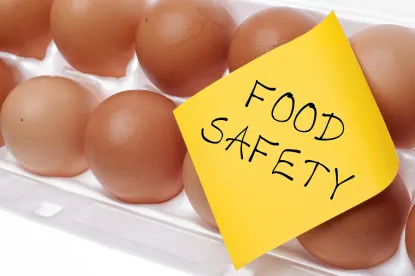EU food safety authorities are still feeling the repercussions of the insecticide-contaminated eggs crisis. That crisis highlights the many challenges of dealing with unsafe and non-compliant products in a single European market, such as a lack of cooperation between EU authorities, traceability difficulties and widely varied national safety and testing standards.
Addressing similar challenges in the online marketplace is even more exigent, especially with regard to on-the-spot inspections, sample testing, and identifying responsible companies. The rapid development of the internet and mobile information technology has also spurred the growth of online counterfeit sales. At the same time, e-commerce continues to grow significantly in Europe, changing the face of many sectors of the global economy.
However, the existing EU product safety regulations are ineffective in dealing with online sales of products as discussed further. The new guidance from the European Commission on how to apply the existing framework to an online environment can therefore help businesses in better understanding their respective duties and potential liabilities.
Current EU Product Safety Rules Unclear about Online Sales
Absent any specific product regulation,[1] the EU General Product Safety Directive (GPSD) governs health and safety concerns of products being sold in Europe. The GPSD covers products intended for consumers in the European Economic Area (EEA).[2]
The GPSD – similarly to the U.S. Consumer Product Safety Act – requires manufacturers, importers, distributors, and retailers of consumer products to report to national authorities any information which reasonably supports the conclusion that a product does not comply with EU safety regulations or contains a defect which creates a product hazard or risk of injury or harm. There is a presumption under the GPSD that a product is safe if it satisfies the relevant European harmonized health and safety standards.[3]
The GPSD dates back to 2001 and clearly applies more readily to sales at brick-and-mortar stores than to online sales from manufacturers, importers or distributors, located either in or outside the EEA. One key issue is how liability may be possibly allocated among the various online supply chains actors. The GPSD does not even mention non-face-to-face sales of goods through the Internet, e-mail, direct mail, telephone, smart phones, and other communication technologies.
New Guidance for the Online Marketplace
On August 1, 2017, the European Commission published some welcome guidance on how national authorities can effectively detect and deter unsafe product sold online by applying the GPSD. The guidance note also identifies the duties and liabilities of the various economic operators all along the business-to-consumer online supply chain.
Key takeaways for companies selling, shipping or distributing products online in the EEA are:
-
Determination of Jurisdiction. To determine jurisdiction over companies based outside the EEA, authorities will consider if the company offers products online to the EEA market on the basis of the following criteria: use of an EU language; accept euro currency; domain name registered in an EU country; delivery possibilities to the EEA market.
-
Responsibility of Manufacturers. In an online environment, manufacturers continue to bear the main pre- and post‐sale responsibilities for product safety and required corrective measures, such as recalls.
-
Duties of Distributors. Distributors are mainly required to actively monitor the safety of products placed on the market, especially by verifying whether the product fulfills the EU requirements for safety, health and environmental protection; verifying whether the product fulfills the marking, labeling and/or packaging requirements, such as mandatory symbols and/or pictograms that contain information concerning safety, health, energy efficiency and/or environmental issues; keeping documentation needed for tracing the origin of products; and cooperation in corrective actions taken by manufacturers or imposed by authorities.
-
Third Party Handlers’ Role. Special focus is given to the role and duties of so-called fulfillment houses which are third party services (storage; packing; shipping; dealing with returns) that take care of fulfilling client orders on the business owner’s behalf. Outsourcing warehousing and fulfillment are central to many e-commerce businesses. The guidance note mentions that in certain cases fulfillment houses may actually qualify as manufacturers if, for example, they affix their name or trademark on the products. More likely, however, they would qualify as distributors (unless they are mere parcel service providers) and thus have to carry out the above described duties.
-
Liability for Online Platforms. E-commerce platforms and online intermediary service providers are not usually legally liable for the safety of goods supplied by third-party merchants through their platforms. However, even in case the intermediary only provides hosting activities to the merchant, the guidance note specifies that authorities can force them to stop offering unsafe or non-compliant products. In addition, they can be required to remove or disable third party content. However, authorities cannot impose a general duty to monitor the content or actively identify unsafe or non-compliant products being offered. Blocking webpages offering dangerous or non-compliant products is another possible enforcement action.
Upgrade Your Sales / Distribution Contracts and Compliance Policies
In view of this new guidance from the European Commission, companies should:
-
Identify how the business activities (production; import; distribution; shipping) qualify under the GPSD and what duties this brings along;
-
Anticipate possible liability risks at every level of the online supply chain in view of the guidance’s enhanced focus on the responsibilities of each economic operator, and the emphasis on active surveillance and intervention of authorities;
-
Review contractual arrangements with other supply chain actors so as to limit potential liability exposure and clearly describe and distinguish respective roles and duties;
-
Keep on top of the constantly evolving regulatory landscape concerning EU safety standards and upgrade compliance policies if needed;
-
Develop an internal strategy on how to deal with government enforcement actions and/or enquiries from business partners.
[1] Such specific product regulations are rare and relate in particular to products containing chemicals or products posing a danger to children.
[2] The EEA consists of the 28 EU countries plus Iceland, Liechtenstein and Norway.
[3] For an overview by industry, see: http://ec.europa.eu/growth/single-market/european-standards/harmonised-standards_en


 />i
/>i

